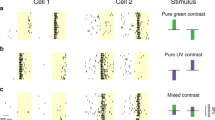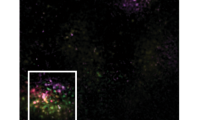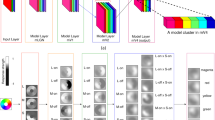Abstract
Human vision has the remarkable property that, over a wide range, changes in the wavelength composition of the source light illuminating a scene result in very little change in the colour of any of the objects1. This colour constancy can be explained by the retinex theory, which predicts the colour of a point on any object from a computed relationship between the radiation from that point and the radiation from all the other points in the field of view (Fig. 1). Thus the computations for colour perception occur across large distances in the visual field. It has not been clear, however, whether these long-range interactions take place in the retina or the cortex. Reports that long-range colour interactions can be reproduced binocularly when one band of wavelengths enters one eye and a different band enters the other2 might seem to establish the cortex as the site of the computation. Many observers, however, see very unsatisfactory colour or no colour at all in this binocular situation, suggesting that the cortex may not be the only site at which the computation is carried out, or even the most important site. We have now tested the role of the cortex in a human subject in whom the nerve fibres connecting cortical areas subserving two separate parts of the visual field had been severed, and find that the cortex is necessary for long-range colour computations.
This is a preview of subscription content, access via your institution
Access options
Subscribe to this journal
Receive 51 print issues and online access
$199.00 per year
only $3.90 per issue
Buy this article
- Purchase on Springer Link
- Instant access to full article PDF
Prices may be subject to local taxes which are calculated during checkout
Similar content being viewed by others
References
Land, E. H. Proc. natn. Acad. Sci. U.S.A. 45, 115–129, 636–644 (1959); Am. Scient. 52, 247–264 (1964).
Geschwind, N. & Segal, J. R. Science 131, 608 (1960).
Land, E. H. Proc. R. Instn Gt Br. 47, 23–58 (1974).
Daw, N. W. Nature 196, 1145 (1962).
Land, E. H. Proc. natn. Acad. Sci. (in the press).
Land, E. H. & McCann, J. 61, J. opt. Soc. Am. 61, 1–11 (1971).
Author information
Authors and Affiliations
Rights and permissions
About this article
Cite this article
Land, E., Hubel, D., Livingstone, M. et al. Colour-generating interactions across the corpus callosum. Nature 303, 616–618 (1983). https://doi.org/10.1038/303616a0
Received:
Accepted:
Issue Date:
DOI: https://doi.org/10.1038/303616a0
This article is cited by
-
Face-infringement space: the frame of reference of the ventral intraparietal area
Biological Cybernetics (2012)
-
Cortical modulation of visual contrast
Psychological Research (1991)
-
The neurophysiological correlates of colour and brightness contrast in lateral geniculate neurons
Experimental Brain Research (1991)
-
Color categorization and color constancy in a neural network model of V4
Biological Cybernetics (1991)
Comments
By submitting a comment you agree to abide by our Terms and Community Guidelines. If you find something abusive or that does not comply with our terms or guidelines please flag it as inappropriate.



